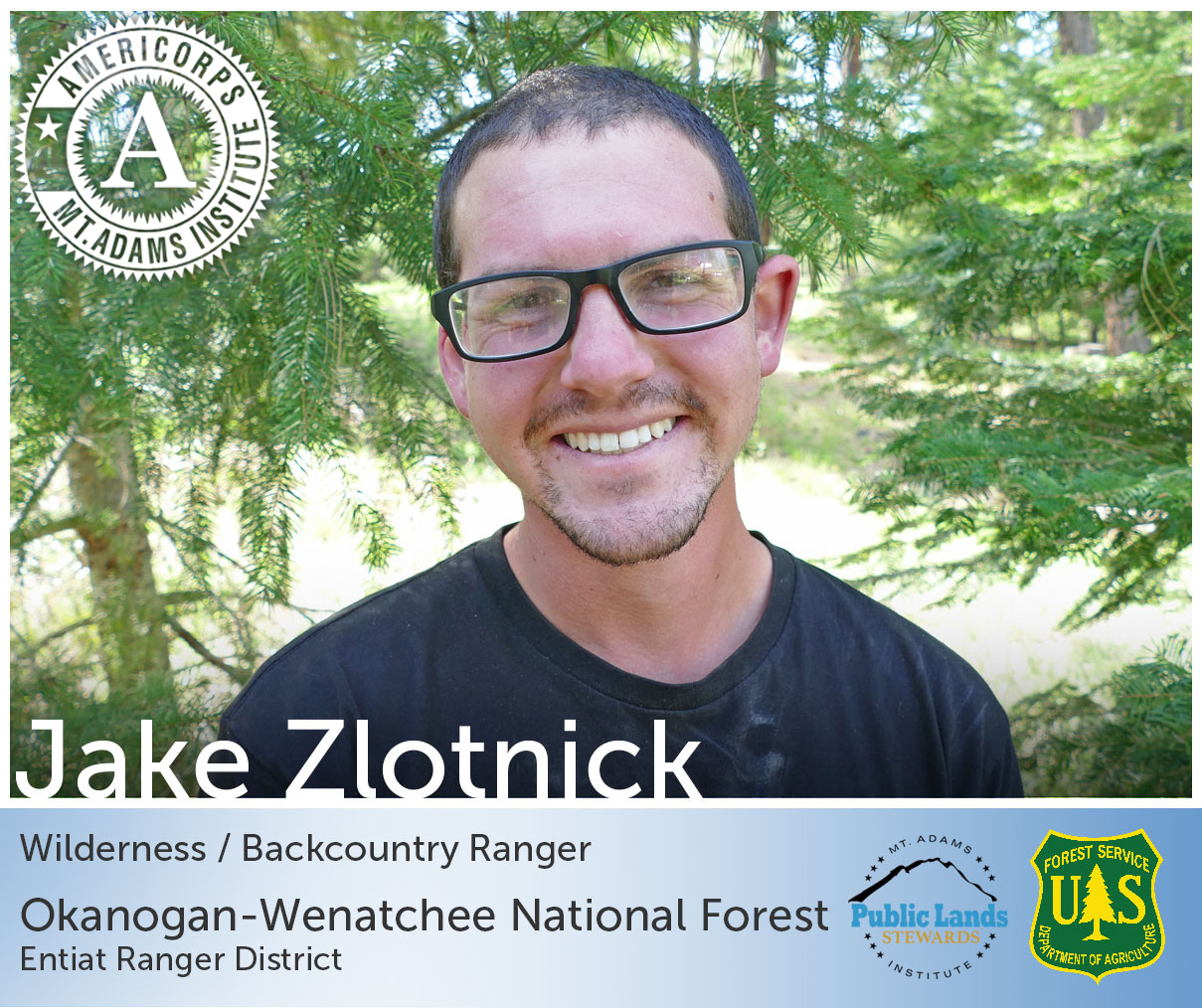
The following are potential hazards that a wilderness backcountry ranger on the Okanogan-Wenatchee National Forest might face on a daily basis. This is not an attempt to scare anyone away from spending a season in this position, but serves as a list of some of the challenges that make this job remarkable. Working as a wilderness ranger is not dangerous as long as you plan ahead, prepare, and use common sense. I would argue that statistically, it is more dangerous working at a restaurant than as a wilderness ranger, although you are less likely to get hypothermia or attacked by an animal bussing tables (both have happened).
1. Falling Trees
You will never be sent out to work on a fire, although you may discover one burning and be obligated to call it in. You will work in burn areas, which are sections of forest that fire ran through, but have long been cool to the touch. The most devilish hazard here is falling trees. Wind certainly helps, but snags (dead trees) can come down at any time for no reason. If camping in a burn area, look up before you lay out your tent. Early in the season, we were planting trees at a developed campground surrounded by burn, and the wind came up. Snags were coming down all around us (we were safely out of reach with hard hats on). In one strong gust about 20 charred poles came down with what sounded like a burst of machine gun fire. But don’t be fooled, green trees fall too. A group of us from Entiat and Chelan Ranger Districts were camping in the Methow Valley, attending a wilderness management training. Everyone had just gone to bed when a massive tree fell less than 50 yards from our site. Again, mind where you camp, and always be ready to dodge a falling tree when working in the woods.
2. Weather
Weather is to be taken seriously in the Okanogan-Wenatchee National Forest. The elevation of the Forest ranges from around 1000ft to over 9000ft, and the weather in any given week has a similar range. At the end of June, my partner and I were assigned to patrol the Upper Mad River dirt bike area, a large, flat basin that sits at about 5500 ft. The temperature was cool and dark clouds blocked the sun as we started on the 10 mile hike in via North Tommy Trail. Rain and thunder began midday. Already soaked to the bone, there was a sudden temperature drop and the rain turned to sleet and snow in the late afternoon. Feeling advanced hypothermia lurking, we decided to make camp on trail and ride it out. An hour in the tent and 22 degree bag was better than a sip from the fountain of youth. On the opposite side of the spectrum, it gets hot in the East Cascades. Exposure is very real in a shadeless burn area. We were lucky this year with a near record snow pack, and a wet, cool summer. But some years the streams run dry and the temperatures hit 95+ above 6000 ft. Carrying 6 liters of water is usually not the beginning to an adventure story. Also, lightning can be benign, and if you are accustomed to storms you know when it is safe. But if ever in doubt, pull out. Getting your toe nails blown off (at the very least) is a steep price to pay for a volunteer position.
3. Animals
I saw a cougar on our Upper Mad River redemption trip in mid-July. The dirt bike trails had just been opened a day prior. I left camp at the blue creek guard station at 830, and a half hour later I was face to face with a large cat. Ten feet off the trail between a stand of adolescent lodge pole pines, an angry face on a buff body starred me down. I froze in deep fear as a blur took off across a meadow and out of site. The blur must have fallen into the creek in the meadow because the tension was broken by a large splash. Feeling relieved that the cats are as afraid as me, I continued hiking. Black bears are around too, but just as skittish as the cats, and both are well fed. Driving up to North Fork trailhead we scared the scat out of a 250 pound Bear, and it was gone before his dust settled. My partner walked up on one on the lake creek trail 10 yards ahead of me and I only heard the brush it displaced as it disappeared. Cougars and black bears can be extremely dangerous if you catch them at the wrong time, but that is unlikely. It’s the deer and goats you need to be concerned about. First, don’t urinate 100 ft from where you are sleeping unless you want a deer party keeping you awake. Herbivores are salt deprived in the cascades, and will eat your urine and enjoy it. Rodents have been known to chew the cork from trekking poles for the sodium (much to posh hiker’s dismay). Never urinate in front of a mountain goat. Never stomp your feet at a mountain goat. Stay away from mountain goats, especially in the enchantments. Two hours into my first venture to the Middle Alpine Lakes, I was pushed off trail by a father protecting his son, although they seemed to be posing for a photo rather than threatening me. Nevertheless, I gave them a wide lane, for an adult goat could push a strong hiker off a cliff face without effort (especially where I met them, the most technical section of the enchantments trail, and it was covered in snow). The area also hosts Rattle Snakes, but as long as you watch where you step and don’t provoke them, the chances of a bite are very low.
4. Trail
Most of the trails that I patrol are breathtakingly beautiful. Steep climbs over passes and up to alpine lakes, ridge lines with 360 degrees of big sky mountains, and old growth treks crossing countless streams. One false step could prove fatal; tumbling down a scree field, free falling off a 1500 foot cliff, slipping into swift, chilly waters. My partner slipped off a log and plunged into Cow Creek in June. Had he not been wearing his hard hat he could have sustained head trauma from the rock that caught him. Smaller hazards such as roots, rocks and rutted out tread can handicap your lower half. Watch your footing and step with purpose. A sprained ankle is a serious situation 15 miles from the trail head.
5. Tools
The tools we use can incite bloody injuries if not used correctly or maintained to standard. Silky and katana hand saws are effective ways to remove logs from trails and are small compared to their cutting power. They make up for their size in the sharpness of their teeth. When the hinges on these saws become loose (as they frequently do), opening and closing becomes a finger-Russian-roulette type game. After cutting a log in late May, I began to close my katana and the blade swung down with the full force of gravity and closed on my left index finger. Had I not been wearing leather gloves, it might have been more (or less) than a bloody mess. The act of removing logs from the trail can also be sketchy business with logs under bind and working on steep terrain. After a log is cut and free, gravity can send it your way with force and vengeance. Always abide by the principles taught in cross cut training. Swinging tools are a danger to yourself and those around you. When swinging, make sure to control the area that the tool is moving through (the blood bubble). Heads of axes and Pulaski’s shatter and fly off in random directions. Always check the soundness of the tool before working with it. Although not as commonly used, working with chainsaws is statistically dangerous as it gets. For all tools, especially saws: Personal Protective Equipment (PPE) is required along with a confident understanding of what you are using and why you are using it. Use the right tool for the right job and always size up the scene. My favorite of the cardinal rules of trail work is “a dull tool is a dangerous tool”.
6. Wear and Tear
Carrying a 50+ pound pack and trail tools over long distances in rugged terrain will destroy your body. Always move at a comfortable pace, use proper body mechanics, and stretch as much as you can. Use your off days to relax and recuperate. If you are like me and need an exercise fix every day, do low impact workouts like cycling or swimming. I’ve also found that abdominal workouts paired with pushups are great for increasing endurance and strength for work. Listen to your body. If you charge too hard your ability to work in the future will be affected.
Being a backcountry ranger through Mt. Adams Institute’s Public Lands Stewards program is the most invigorating thing I have ever done. To successfully complete the season, you must have situational awareness at every moment. Circumstances change, things go south, and adventures begin. I hope to soon start a career with similar and exciting new occupational hazards.

